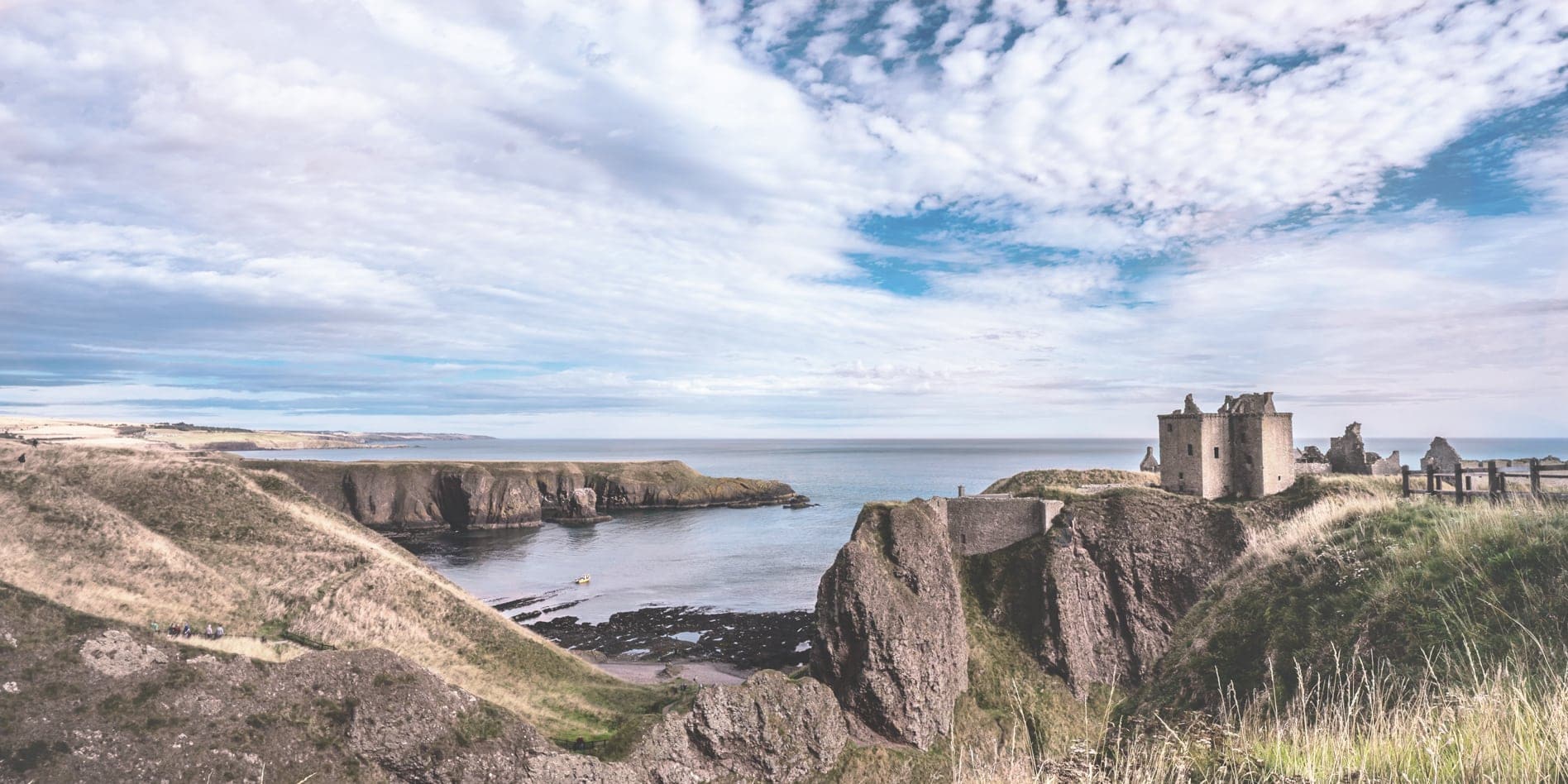The Stonehaven to Dunnottar Castle walk takes you from the heart of the popular quaint fishing village of Stonehaven to one of Scotland’s most dramatic clifftop castles, Dunnottar Castle.
The Stonehaven coastal pathway gently meanders along this rugged coastline, showcasing the nature and history of the area.
Walking from Stonehaven to Dunnottar in Aberdeenshire, you’ll pass a Roman Temple-styled war memorial, encounter a myriad of spectacular views and arrive at the pièce de résistance, the ancient ruins of Dunnottar Castle.
🏰 What’s In This Article: Stonehaven to Dunnottar Castle Walk
- 🚶🏼♂️➡️ Overview of the Stonehaven to Dunnottar Castle walk
- 🗺️ Map: Where is Stonehaven and Dunnottar Castle?
- 🥾 The Dunnottar Castle Walk
- 👀 Attractions On The Castle Walk

Overview: Stonehaven to Dunnottar Castle Walk
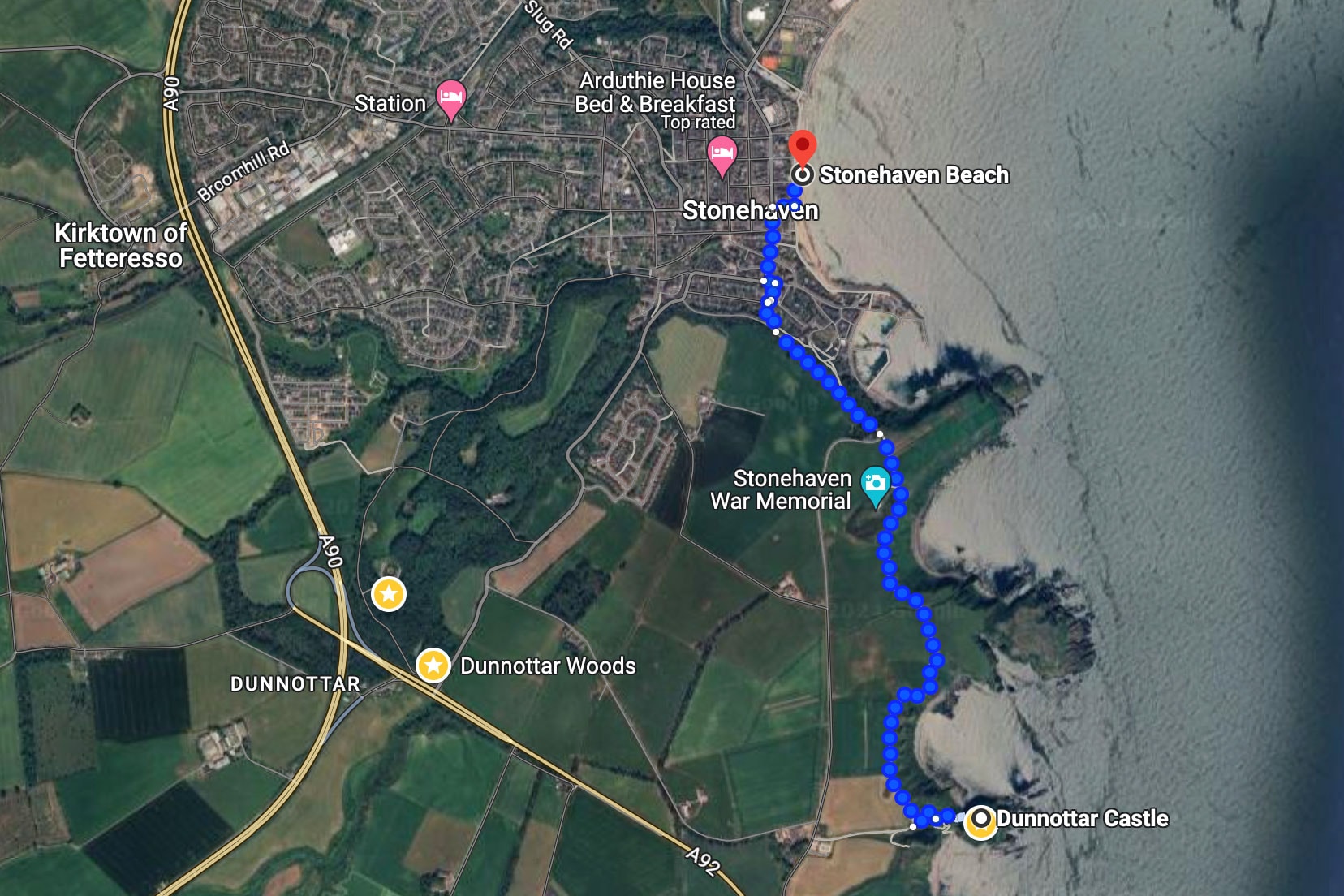
Begin your journey at the charming fishing village of Stonehaven, where free parking is conveniently available near the harbour. This scenic walk leads to the striking ruins of Dunnottar Castle, perched dramatically on a rugged clifftop.
Starting Point: The walk commences from the free car park behind the Old Tollbooth Museum in Stonehaven.
Route Details:
- Harbourfront to Signpost: Follow the coastal pathway that meanders along the harbour, passing landmarks like the Old Tollbooth Museum and the Ship Inn.
- Climb to Main Road: The path, although paved, becomes steeper and may be slippery, especially in wet conditions.
- Coastal Path to Castle: At the main road, continue to the coastal gravel path that leads to Dunnottar Castle. This path offers splendid views and historical sites like the Stonehaven War Memorial and Dunnicaer Sea Stack.
Trail Length: Approximately 1.5 miles (2.4 km) one way, or 3 miles (4.8 km) for a round trip.
Duration: The walk typically takes about 30-45 minutes each way. However, if you plan to stop for photos or enjoy the views, allow extra time.
Accessibility: Some sections of the trail are steep and potentially slippery, which may be challenging for young children, the elderly, or those with mobility limitations.
Best Time to Visit: Early morning or late afternoon are ideal for avoiding crowds and for optimal photography conditions with softer light. The path is accessible year-round.
What to Bring:
- Sturdy walking shoes or boots
- Water and snacks
- Camera or smartphone for capturing memorable moments
- A hat and sunscreen for sunny days; a waterproof jacket for rainy conditions
Additional Tips:
- Set off early to avoid crowds, especially during the tourist high season.
- Keep an eye on the weather forecast as conditions can change quickly along the Scottish coast.

Map: Where is Stonehaven and Dunnottar Castle?
Both Stonehaven and Dunnottar Castle are on the northeast coast of Scotland, in Aberdeenshire. They are about a half-hour drive south of Aberdeen.
This map highlights the main points along Stonehaven’s coastal path, as well as parking spots and all places mentioned in this article.
The Dunnottar Castle Walk

Planning a Trip to Scotland?
- 🚗 Hiring a car? We recommend getting a quote from DiscoverCars
- 🚐 Hiring a campervan? We recommend Motorhome Republic
- ⛑ Arranged your travel insurance? Compare quotes from World Nomads & Safetywing
- 🪪 Order your International Driver’s Licence online here
- 🏩 Booked your accommodation? We use Booking.com to find the best deals
- 🐾 Is someone pet-sitting for you? 🐾 We use and love TrustedHousesitters
- (Get 25% off at checkout for new memberships with our discount code: LIFEJOURNEY25)
How Long Does it Take to Walk from Stonehaven to Dunnottar Castle?
Walking from Stonehaven to Dunnottar Castle will take about 30-45 minutes. If you stop off at the War Memorial, however, or are a keen photographer, then it could take a lot longer.
You could easily make a day of it, by walking to the castle in the morning and then exploring Stonehaven during the afternoon.
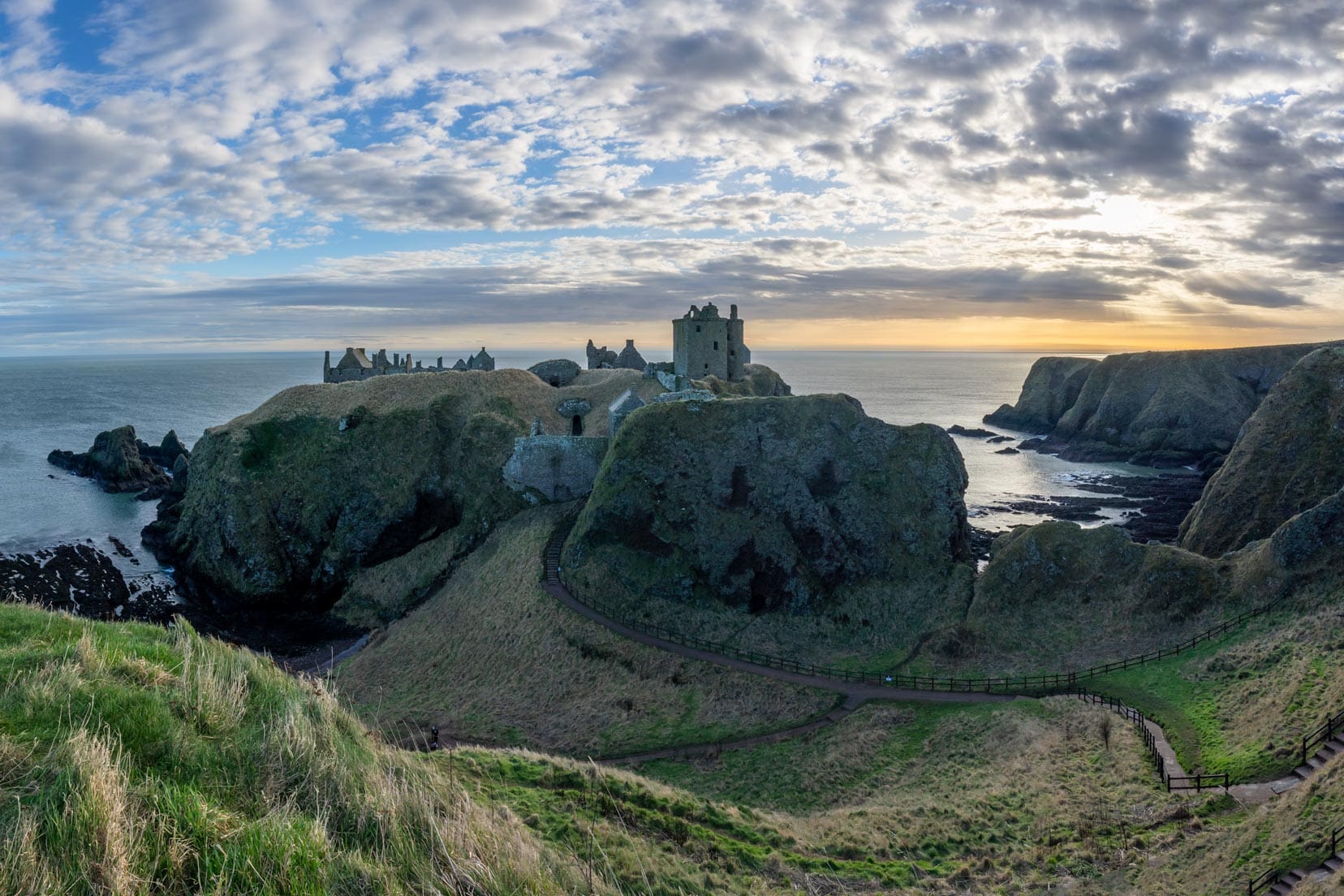
How Far is the Stonehaven to Dunnottar Castle Walk?
If you start the Dunnottar Castle walk from the free carpark behind the old Tolbooth Museum in Stonehaven, then the walk is about 1.5 miles to the castle (3 miles round trip).
If you arrive in Stonehaven by train and walk from there, the walk is about a 5-mile round trip and will take around an hour or so to reach Dunnottar Castle.



Extra Tips for the Stonehaven to Dunnottar Castle Walk
- Wear good walking shoes, as the ground can be slippery, muddy and uneven
- If you don’t want to encounter too many other people, set off early because it’s a popular walking route for locals
- Take your time and stop often to appreciate the views
- You need to pay to visit the inside of Dunnottar Castle Grounds, but it is free to walk down to the steps to the beach beside it
- There are plenty of wooden benches along the coastal path where you can stop and admire the views
- The area around Dunnottar Castle may be busy as it is a popular tourist stop and coach tours also stop here (another reason to set off on your walk early)
- Dunnottar Castle is open 361 days of the year, weather permitting. Tickets can be bought at the castle or online.

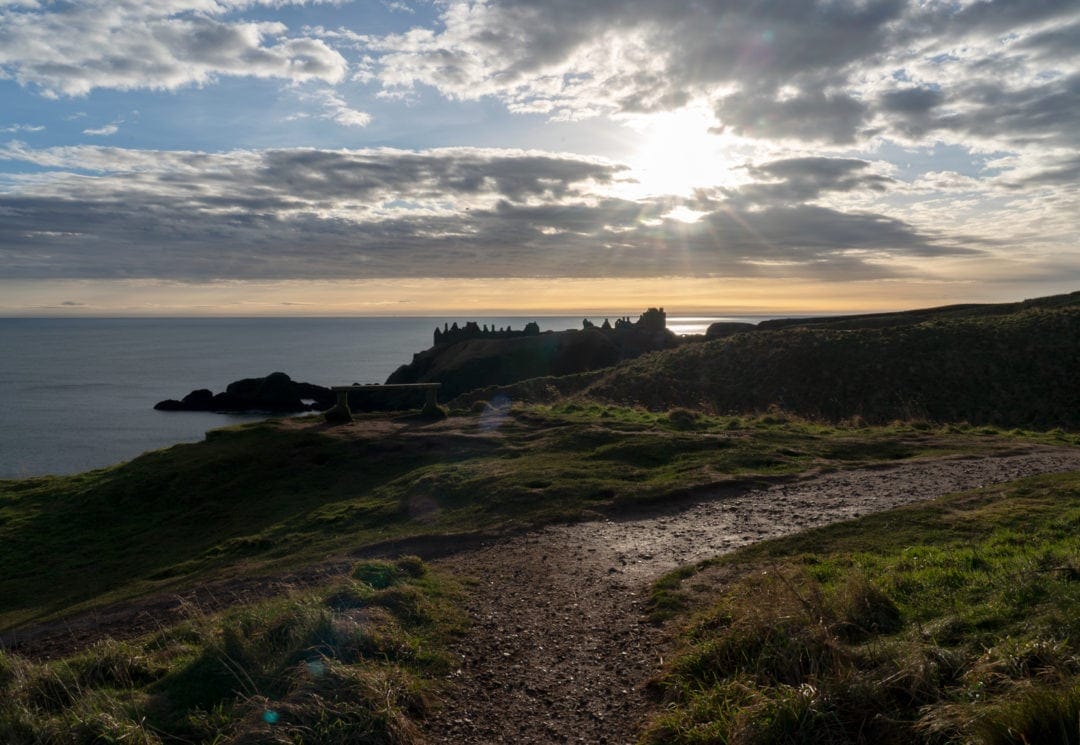

What to Look Out For on the Dunnottar Castle Walk from Stonehaven
Birdseye View of Stonehaven Harbour and Shore
While you are in Stonehaven it’s worth having a look around the town — and it’s definitely worth having a quick look at some of the intricate metal sculptures along the boardwalk, just beside the car park.
One of the first things you’ll see on the boardwalk is the mini lighthouse sculpture. Take a moment to peek in the lighthouse windows. In the top window, you’ll see a sculptured metal bookcase and a sea creature sitting on a couch. In the next window, a creature sitting on a bed, reading — all made of metal.
If you have time, there is plenty to see in Stonehaven, and we also suggest having a walk in the historical Dunnottar Woods nearby, which even has its own tiny fairy doors dotted around the woods. You’ll find all the details in our Stonehaven article.
Once you start the walk from Stonehaven village and have climbed to the top of the first steep incline, you’ll see great views over the town, its harbour and its arced shoreline.




Stonehaven War Memorial
About ten minutes into your walk from Stonehaven, you’ll reach a Grecian-like monument on your right, just at the start of the coastal path. In 1922, locals raised money to build the war memorial, which was completed in 1923.
Sitting high on the top of Black Hill, the Stonehaven War Memorial is more of a destination than just a monument.
Not only does it overlook Strathlethan Bay directly in front, but you also have views northwards along the coast to Portlethen and south to Dunnottar Castle.

Stepping inside the monument, there are more engravings and memorials to fallen soldiers. Initially built to remember lives lost in the First World War, further additions were made after WWII.
Some suggest it was designed as a Roman ruin as a metaphor to represent the ruined lives of those lost. But records are lacking as to the thinking behind local architect John Ellis’ thoughts when he designed the memorial.
Whatever the reasoning, it certainly catches your attention, and once inside, the landscape views through the memorial’s columns are framed beautifully.

Dunnicaer Sea Stack
What we see today as the Dunnicaer sea stack was once a Pictish fort. Around 1700 years ago, sometime in the 1st to 4th century, people, most likely of high status, lived here.
Archeologists from the University of Aberdeen investigated the site in 2015 and found several remains of hearths and houses.
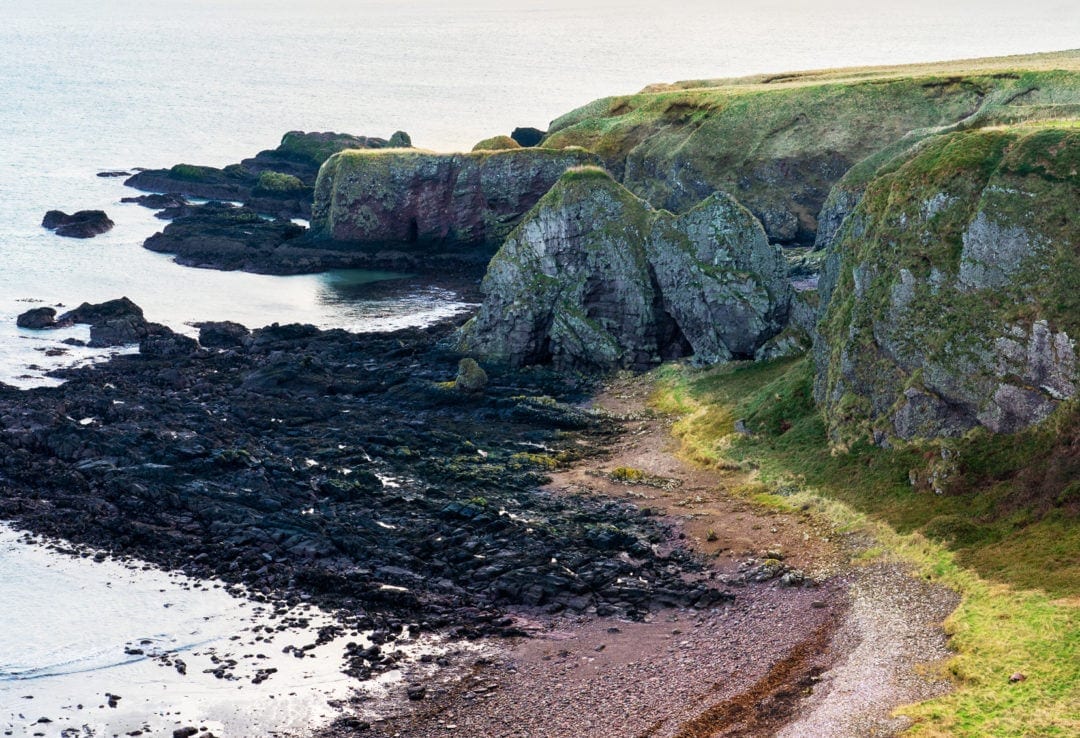
This video by Aberdeen University, explains what they found and what the fort may have looked like. The remains suggest that the Pictish Fort predates the well-known Pictish settlement at Dunnottar Castle, and it may have moved to Dunnottar when the existing site began to erode.
Spot Wildlife and Wildflowers
The walk from Stonehaven to Dunnottar Castle can be done all year round. As the seasons change, so do the views.
We walked on a rainy day, a cold and blustery day, and a calm, sunny day. Each experience was unique.
If you walk from Stonehaven to Dunnottar Castle in spring and summer you’ll see masses of seabirds cruising the coast and might also spot dolphins, seals or even minke whales off the coast.

The first time we walked from Stonehaven to Dunnottar Castle, the weather was wet and drizzly. We’d arrived in Stonehaven around lunchtime and parked looking out to sea by The Bay Fish and Chips, a local chippy renowned for its tasty locally sourced fish. This was the perfect opportunity to try their famous fish and chips while waiting for a heavy rain shower to pass.
We sat in the car nodding and ‘mmm’ ing, as we enjoyed each mouthful. Seagulls watched us through the windscreen as they sat on the sea wall, expectantly waiting for any remnants to be discarded. They were out of luck.

But it’s not only seagulls that like to hang out around Stonehaven and the coastal path to Dunnottar Castle. Thousands of seabirds return in spring for the breeding season and settle on the ledges of the craggy cliffs along this part of the coast. You may spot Kittiwakes, razorbills, guillemots, fulmars and gulls.
In winter, the coastal path is lined with bright yellow gorse flowers, and a variety of wildflowers bloom in spring and summer.
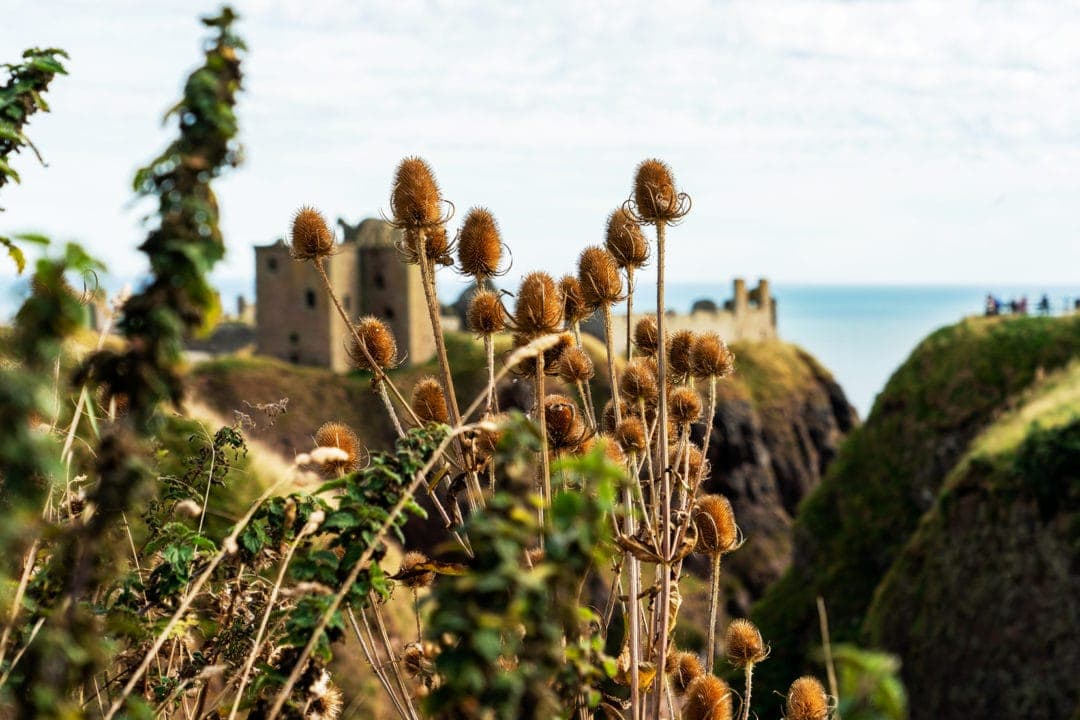


Dunnottar Castle
The prized gem of the walk has to be the dramatic ruins of Dunnottar Castle.
The earliest records show that a missionary set up a place of worship on the site in about 400 AD. Since then, the castle has been attacked by Vikings, ownership has passed to and fro between Scotland and England, it has been plundered and burned, it has been home to the Scottish Crown Jewels, and it has even been home to a pet lion.
William Wallace, a Scottish hero and one of the first leaders in the first war of Scottish Independence, led the Scots to victory against the English at Dunnottar in 1296. The story goes that he trapped the captured English soldiers in the Dunnottar chapel and burnt them alive.

In 1393, William Keith, the Great Marischal of Scotland, and incidentally my 19th great grandfather, built the first stone Castle here, known today as The Keep. After much toing and froing over 400 years, Clan Keith had to finally relinquish Dunnottar.
This is because George Keith, 10th Earl Marischal, was part of the first failed Jacobite Rising of 1715, to overthrow King George I. As a result, in 1717, he had to forfeit his title and estates, including Dunnottar Castle.
(This Jacobite rebellion isn’t to be confused with the failed 1745 Jacobite rebellion led by Bonnie Prince Charlie and the devasting defeat at Culloden.)
Its sale to the York Mining Company stripped it of any value. It wasn’t until 1919 that Lord and Lady Cowdray bought the Castle and began extensive conservation and restoration works. Dunnottar Castle still remains in the Cowdray family.

Dunnottar Castle is a photographer’s dream. The mood around the castle changes with the Scottish weather and the time of day.
Dunnottar’s historical tales and wild surroundings make it one of Aberdeenshire’s most visited spots.
The path and many steps leading down to the castle also lead to the beach.




FAQs
How Hard Is the Dunnottar Walk?
The Dunnottar Walk from Stonehaven is a relatively easy 1.8 mile (2.9 km) hike with some steep sections on a path that can sometimes be muddy and slippery.
How Long Do You Need At Dunnottar Castle?
If you are entering Dunnottar Castle then three hours spent here would be enough. If you do not intend to enter, 1.5 hours would be sufficient time for a visit.
Can You See Dunnottar Castle Without Paying?
Yes, you can see Dunnottar Castle without paying. You have great views of Dunnottar Castle’s exterior from the nearby hills. However, to step inside the ruins, you need to pay.
Stonehaven to Dunnottar Castle Walk … That’s a Wrap

Whatever time of year you walk this incredibly scenic coastal path from Stonehaven to Dunnottar Castle, I’m sure you’ll enjoy its rugged nature.
Salty breezes blow in from the North Sea and the seabirds’ calls echo against the steep cliffs below. And, as Dunnottar Castle makes its appearance, the whole experience becomes quite magical.
Please contact us with any questions you have and do tell us if you’ve done this walk and what your highlight was.
As always, thanks for stopping by, we appreciate your support.
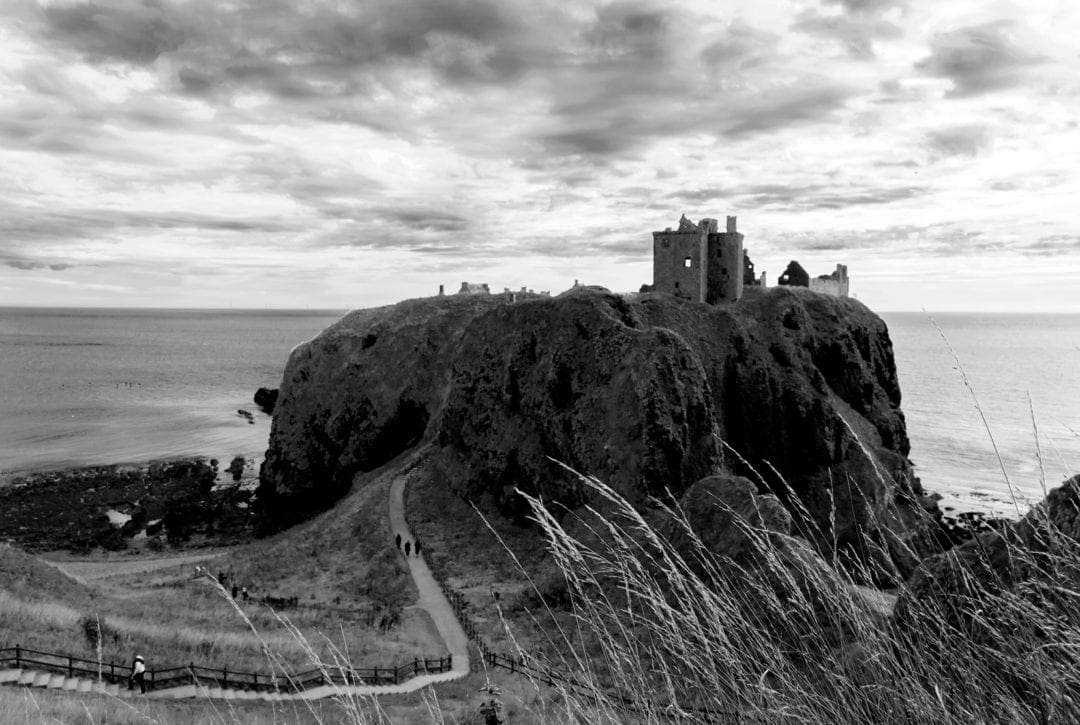
Are you following us on Social Media?
Join us on Facebook or Instagram for more updates and photos. We love to hear from you so say hello and tell us about your travels.

Read More:
- Scotland Travel Guide and Inspiration
- 33 Best Things to Do in Aberdeenshire
- The Very Best Scottish Castle Tours
- 15 Fabulous Things to do in Stonehaven
- 21 Best and Free things to do in Aberdeen
- The Wonder of Newburgh Seal Beach
Planning Your Travels?
These are the travel resources we recommend and use when planning our trips.
- 🚘 Car Hire: We use DiscoverCars.com
- Motorhome/Campervan Rental: We highly recommend the Motorhome Republic
- 🪪 Order your International Driver’s Licence online here
- 🛏 Book Accommodation: We use Booking.com to find accommodation that suits our budget
- 🐶 Pet Sitting/Pet Sitters: Check Out TrustedHousesitters here (Use our Discount code: LIFEJOURNEY25 for 25% off. )
- Activities and Experiences: Get Your Guide and Viator
- Travel Insurance: Safetywing or World Nomads
- 🥾 Travel Gear and Accessories: Check out our top picks here — Lifejourney4two page on Amazon
For a more thorough list, visit our Travel Resources page here.

